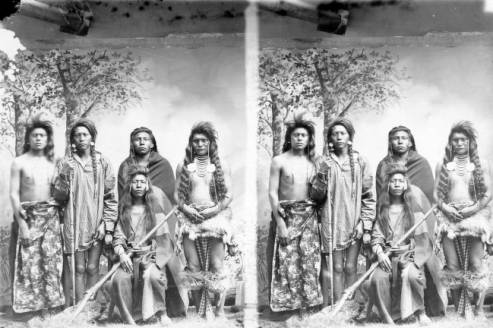A History of Utah’s American Indians, © 2000 “Introduction,” pp. xi-xx Forrest S. Cuch The day will come, when a white people will set foot on the eastern shores and claim this land as their own. They will build a white house near the shore from where they will govern their people. Upon establishing their government, they will raise …
A History of Utah’s American Indians, Chapter 3
A History of Utah’s American Indians, © 2000 “The Goshute Indians of Utah,” pp. 73–122 Dennis R. Defa A group of Goshute Indians, date unknown The Goshute Indians live in a little known and sparsely populated portion of the state of Utah. There actually are two Goshute reservations, the largest of which is the Deep Creek Reservation located on …
A History of Utah’s American Indians, Chapter 2
A History of Utah’s American Indians, © 2000 “The Northwestern Shoshone,” pp. 25–72 Mae Parry In early historic times the Shoshone Indians were a large nation of Indians who lived and traveled over an extensive territory that included parts of Idaho, Utah, Nevada, and Wyoming. Usually groups of extended families traveled together in varying numbers according to the season and …
A History of Utah’s American Indians, Chapter 1
A History of Utah’s American Indians, © 2000 “Setting the Stage: Native America Revisited,” pp. 3–24 Robert S. McPherson The writing of Native American history can be said to have started when Christopher Columbus first waded ashore on San Salvador Island in the Caribbean. It has continued ever since. What preceded his arrival–the prehistoric phase of Native Americans–has generally been …
The Peoples of Utah, The Oft-Crossed Border: Canadians in Utah
The Peoples of Utah, ed. by Helen Z. Papanikolas, © 1976 “The Oft-Crossed Border: Canadians in Utah,” pp. 279–301 by Maureen Ursenbach and Richard L. Jensen Probably the first significant meeting of two Canadians in what is now Utah took place on the banks of the Weber River, east of present Ogden, on May 23, 1825. There, around mid-morning, Peter Skene …
The Peoples of Utah, The Utes, Southern Paiutes, and Gosiutes
The Peoples of Utah, ed. by Helen Z. Papanikolas, © 1976 “The Utes, Southern Paiutes, and Goshiutes,” pp. 27–59″ by Floyd A. O’Neil “….. teach ’em to speak Ute. And don’t let them ever forget how we’re supposed to live, who we are, where we came from.”…Connor Chapoose Confined on reservations, no longer free to range over the mountains and deserts …
Ethnic Cultures. Selected Bibliography
African American Bringhurst, Newell G. “An Ambiguous Decision: The Implementation of Mormon Priesthood Denial for the Black Man — A Reexamination,” UHQ 46 (1975): 45-64. Clark, Michael J. U.S. Army Pioneers: Black Soldiers in Nineteenth-Century Utah. Salt Lake City, 1981. ________. “Improbable Ambassadors: Black Soldiers at Fort Douglas, 1869-99,” UHQ (1978): 282-301. Coleman, Ronald G. “The Buffalo Soldiers: Guardians of …
This Is the Place
The Mormon Trail: A Photographic Exhibit Stan Layton After leaving Nauvoo, Illinois, in 1846, the Mormons headed west. They spent the winter of 1846–47 in Winter Quarters near Omaha and at various places in Iowa, resuming their journey in the spring. First to leave Winter Quarters that spring was the advance party under the personal direction of church president Brigham …
The Sego Lily, Utah’s State Flower
History Blazer, December 1995 The Sego Lily is a sacred plant in Native American legend. Sego is a Shoshonean word thought to mean “edible bulb.” The flower thrives in desert-like conditions. It blooms in May and June. There are about seven variations of the plant in Utah. The white flower species displays three large, waxy petals. Each petal, on the …
Chief Pocatello
CHIEF POCATELLO STRUGGLED TO SURVIVE ON UTAH’S NORTHERN FRONTIERW. Paul ReeveHistory Blazer, February 1995 Chief Pocatello came to be known in the 1860s among Mormon leaders, Indian agents, and army officers headquartered in the Salt Lake area for his exploits as the head of a so-called outlaw band of Indians. Although the Shoshones under Pocatello’s lead did terrorize settlers and …

